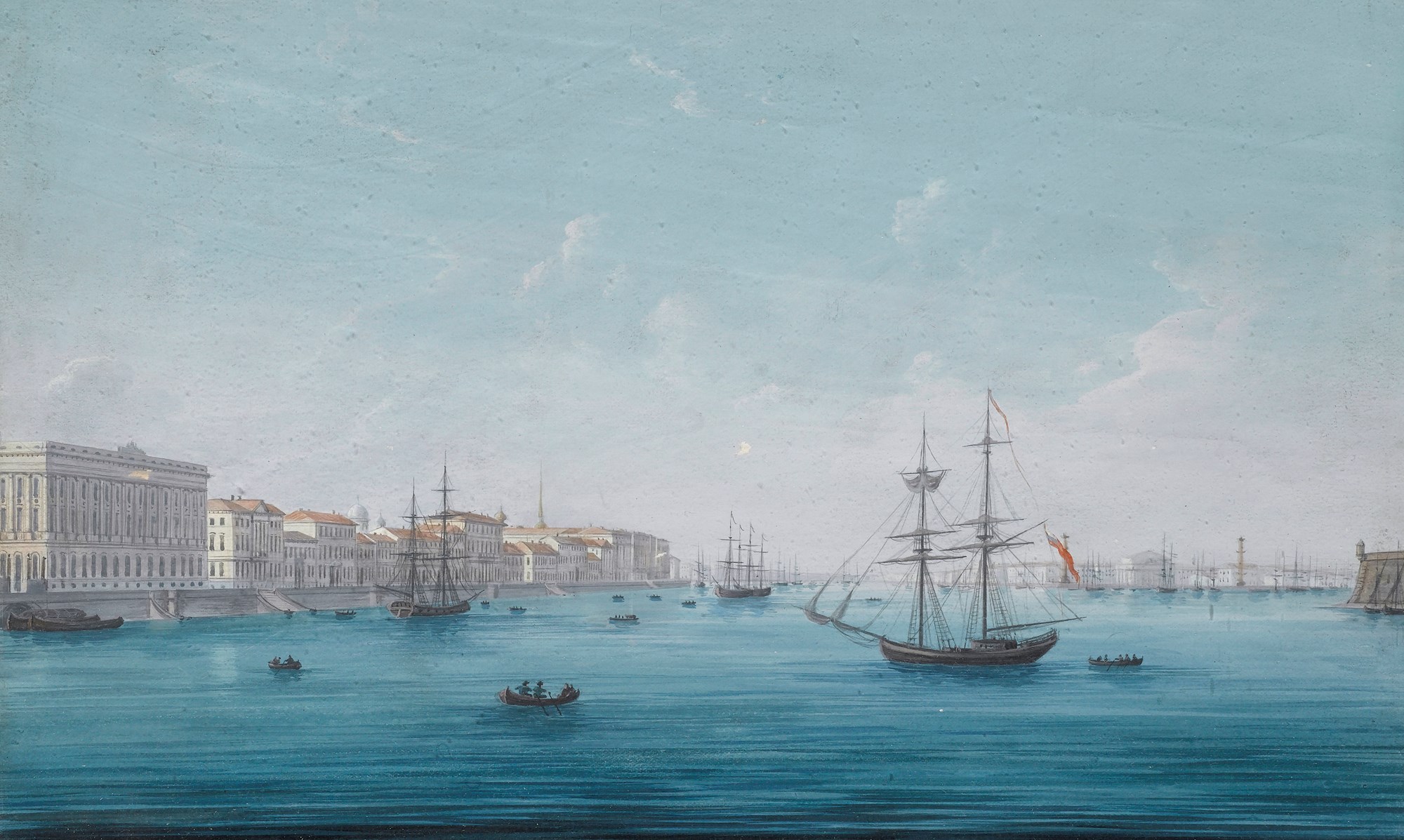Marketplace
A View of the Neva River, St. Petersburg
School Neapolitan
A View of the Neva River, St. Petersburg
Date 19th century
Epoque 1750-1850, 1850-1900, 19th century
Origine Italy, Naples
Medium Gouache on paper
Dimension 22 x 35.5 cm (8⁵/₈ x 14 inches)
In this majestic work, a grand panorama of the Neva River and its impressive embankments is portrayed. The left-hand river bank is known as Angliyskaya Naberezhnaya or ‘English Embankment’, where the English embassy was located and which once served as the main port of call for English traders. Behind the buildings in the distance, the distinctive domes of Russian church architecture can be seen. To their right, the famous spire of the Admiralty, a dockyard where some of the first ships of Russia’s Baltic Fleet were built, stretches into the sky.
Just visible at the right-hand edge of the painting is the corner of the Peter and Paul Fortress, founded in 1703. It is the first and oldest landmark of St. Petersburg and marks the city’s birth. Ultimately it never saw any fighting but part of it was converted to serve as a high security political prison, housing famous inmates such as Fyodor Dostoyevsky (1821-1881), Maxim Gorky (1868-1939), Leon Trotsky (1879-1940) and Lenin’s older brother, Alexander Ulyanov (1866-1887). Behind it on the horizon stands the Alexander Column, the focal point of Palace Square. It is a monument to Russia’s military victory in the war against Napoleon’s France and named after Tsar Alexander I (1777-1825), who ruled Russia between 1801 and 1825, during the Napoleonic Wars.
The Neva River, its banks lined with architectural splendours such as the Winter Palace, carves a graceful pattern through the heart of the city. As such, it has held a strong aesthetic allure for artists eager to depict its beauty. The river occupies a fundamental place within the geographical and cultural heritage of St. Petersburg. From the foundation of the city the river was intended to serve as the main ‘street’ of St. Petersburg, transporting people and goods, just as Peter the Great (1672-1725) intended when he founded his ‘Venice of the North’. This vision is clearly indicated in the present work by the multitude of boats seen ferrying people across the river.
The River Neva extends 2,600 feet across where it flows past the Peter and Paul Fortress. The diagonal line of the embankment leads the viewer’s eye into the centre of the canvas where the diminishing river and buildings create the illusion of space and depth.
With the tall ships that sit elegantly upon the tranquil river and the impressive columned buildings, A View of the Neva River is a picture of order and serenity. A composition dominated by soft, calm shades of blue and white, the well-proportioned lines and controlled, meticulous brushwork evident in the rigging of the ships or buildings of the English Embankment, imbue the painting with an air of refined elegance. Such tones and techniques and a considered, subtle rendering of light define the work of the Neapolitan School at this time. The early nineteenth century vogue for gouache on paper representations of renowned places from Naples to St. Petersburg was ably met by artists like the present one.
Just visible at the right-hand edge of the painting is the corner of the Peter and Paul Fortress, founded in 1703. It is the first and oldest landmark of St. Petersburg and marks the city’s birth. Ultimately it never saw any fighting but part of it was converted to serve as a high security political prison, housing famous inmates such as Fyodor Dostoyevsky (1821-1881), Maxim Gorky (1868-1939), Leon Trotsky (1879-1940) and Lenin’s older brother, Alexander Ulyanov (1866-1887). Behind it on the horizon stands the Alexander Column, the focal point of Palace Square. It is a monument to Russia’s military victory in the war against Napoleon’s France and named after Tsar Alexander I (1777-1825), who ruled Russia between 1801 and 1825, during the Napoleonic Wars.
The Neva River, its banks lined with architectural splendours such as the Winter Palace, carves a graceful pattern through the heart of the city. As such, it has held a strong aesthetic allure for artists eager to depict its beauty. The river occupies a fundamental place within the geographical and cultural heritage of St. Petersburg. From the foundation of the city the river was intended to serve as the main ‘street’ of St. Petersburg, transporting people and goods, just as Peter the Great (1672-1725) intended when he founded his ‘Venice of the North’. This vision is clearly indicated in the present work by the multitude of boats seen ferrying people across the river.
The River Neva extends 2,600 feet across where it flows past the Peter and Paul Fortress. The diagonal line of the embankment leads the viewer’s eye into the centre of the canvas where the diminishing river and buildings create the illusion of space and depth.
With the tall ships that sit elegantly upon the tranquil river and the impressive columned buildings, A View of the Neva River is a picture of order and serenity. A composition dominated by soft, calm shades of blue and white, the well-proportioned lines and controlled, meticulous brushwork evident in the rigging of the ships or buildings of the English Embankment, imbue the painting with an air of refined elegance. Such tones and techniques and a considered, subtle rendering of light define the work of the Neapolitan School at this time. The early nineteenth century vogue for gouache on paper representations of renowned places from Naples to St. Petersburg was ably met by artists like the present one.
Date: 19th century
Epoque: 1750-1850, 1850-1900, 19th century
Origine: Italy, Naples
Medium: Gouache on paper
Dimension: 22 x 35.5 cm (8⁵/₈ x 14 inches)
Plus d'œuvres d'art de la Galerie









